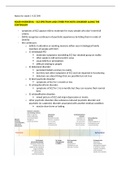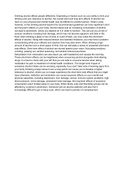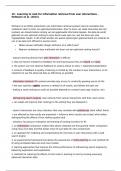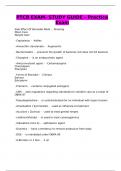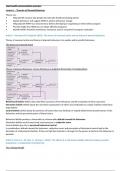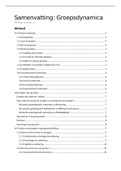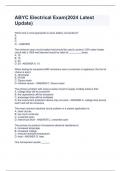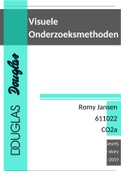Notes for week 1 4.3C SMI
NOLEN-HOEKSEMA – SCZ SPECTRUM AND OTHER PSYCHOTIC DISORDER ALONG THE
CONTINUUM
- symptoms of SCZ appear mild to moderate for many people who don’t meet full
criteria
- DSM5 recognizes continuum of psychotic experiences by listing them in order of
severity
- the continuum:
o deficits in attention or working memory (often seen in biological family
members of people with SCZ)
o 1) schizotypal PD:
moderate symptoms resembling SCZ but retained grasp on reality
often speak in odd and eccentric ways
usual beliefs or perceptions
difficult relating to people
o 2) delusional disorder:
persistent beliefs contrary to reality
but they lack other symptoms of SCZ and not impaired in functioning
delusions are about things that are possible but not true
o 3) brief psychotic disorder:
symptoms of SCZ for 1 month or less
o 4) schizophreniform disorder:
symptoms of SCZ for 1 to 6 months but they can resume their normal
lives
o 5) schizoaffective disorder:
mixed picture of SCZ and major depression or mania
o other psychotic disorders like substance-induced psychotic disorder and
psychotic (or catatonic) disorder associated with another medical condition
may be short term or lasting
, - psychosis!
- most people develop psychotic disorders in late teenage or adult years
- SCZ is chronic
- in the US, 1-2% of the population develops SCZ at some time in their lives
- there are also many with SCZ in jails, prisons, and homeless shelters as in hospitals
and nursing homes
SYMPTOMS, DIAGNOSIS, AND COURSE
- SCZ is a complex disorder with psychosis as its core symptom
- DSM5 refers to the psychotic spectrum
- there are 5 domains of symptoms that define psychotic disorders and their number,
severity and duration distinguish them from each other
o 4 kinds of positive symptoms:
delusions
hallucinations
disorganized thought (speech)
disorganized or abnormal motor behavior (including catatonia)
o negative symptoms (e.g. restricted emotional expression/affect)
o people with SCZ often show cognitive deficits too (but not part of diagnostic
criteria)
SYMPTOMS
Positive symptoms
- positive bc they are overt expressions of unusual perceptions, thoughts and
behaviors
- 1. Delusions:
o ideas that the person believes are true, but they’re very unlikely and often
impossible
o self-deceptions (thinking you’ll win the lottery) vs delusions
1. self-deceptions are at least possible, delusions are not (winning the
lottery is not likely but still possible, but your body dissolving and
floating in space is impossible)
2. people with self-deceptions may think about these beliefs
occasionally, but people with delusions are preoccupied with them
(looking for support, attempt to convince others, take actions based
on them e.g. filing lawsuits against people who they believe are
controlling their minds)
3. people with self-deceptions usually acknowledge that their beliefs
may be wrong, but people with delusions are resistant to
arguments/facts that contradict them (they may view the arguments
as conspiracies, as evidence of the truth of their beliefs)
o delusional beliefs are often complex and elaborate, and several types of
delusions work together in one person’s belief system
o delusions can occur in other disorders like depression or bipolar too
they might believe they have committed some unforgivable act when
they are depressed or they might believe they are god when they are
manic
, o content of delusions can differ per culture
Japanese; delusions of being slandered by others, others knowing you
did smt horrible (due to culture on being thought well by others)
Germans/Austrians; religious delusions of having committed a sin (bc
of Christianity influence in Europe)
o even differences in time frame
in the US; focus on Germans in WW2, focus on Communists during the
Cold War, and focus on technology in recent years
o some say odd beliefs that are part of a culture can’t be considered delusions
instead those who hold extreme manifestation of their culture’s
shared belief systems are considered delusional
- 2. Hallucinations (unreal perception experiences):
o hallucinations in the general population are not uncommon
o hallucinations of SCZ patients are frequent, persistent, complex, and
sometimes bizarre
o they are not precipitated by sleep deprivation, stress or drugs
o it can involve many senses
o auditory hallucinations: (hearing voices, music) are the most common
might be a voice speaking in someone’s mind, carrying on a
commentary on the person’s behavior, collection of voices speaking in
3rd person, voices giving commands etc.
coming from either inside the person’s head or outside
usually negative, criticizing, threatening
people might try to talk back to the voices
NOLEN-HOEKSEMA – SCZ SPECTRUM AND OTHER PSYCHOTIC DISORDER ALONG THE
CONTINUUM
- symptoms of SCZ appear mild to moderate for many people who don’t meet full
criteria
- DSM5 recognizes continuum of psychotic experiences by listing them in order of
severity
- the continuum:
o deficits in attention or working memory (often seen in biological family
members of people with SCZ)
o 1) schizotypal PD:
moderate symptoms resembling SCZ but retained grasp on reality
often speak in odd and eccentric ways
usual beliefs or perceptions
difficult relating to people
o 2) delusional disorder:
persistent beliefs contrary to reality
but they lack other symptoms of SCZ and not impaired in functioning
delusions are about things that are possible but not true
o 3) brief psychotic disorder:
symptoms of SCZ for 1 month or less
o 4) schizophreniform disorder:
symptoms of SCZ for 1 to 6 months but they can resume their normal
lives
o 5) schizoaffective disorder:
mixed picture of SCZ and major depression or mania
o other psychotic disorders like substance-induced psychotic disorder and
psychotic (or catatonic) disorder associated with another medical condition
may be short term or lasting
, - psychosis!
- most people develop psychotic disorders in late teenage or adult years
- SCZ is chronic
- in the US, 1-2% of the population develops SCZ at some time in their lives
- there are also many with SCZ in jails, prisons, and homeless shelters as in hospitals
and nursing homes
SYMPTOMS, DIAGNOSIS, AND COURSE
- SCZ is a complex disorder with psychosis as its core symptom
- DSM5 refers to the psychotic spectrum
- there are 5 domains of symptoms that define psychotic disorders and their number,
severity and duration distinguish them from each other
o 4 kinds of positive symptoms:
delusions
hallucinations
disorganized thought (speech)
disorganized or abnormal motor behavior (including catatonia)
o negative symptoms (e.g. restricted emotional expression/affect)
o people with SCZ often show cognitive deficits too (but not part of diagnostic
criteria)
SYMPTOMS
Positive symptoms
- positive bc they are overt expressions of unusual perceptions, thoughts and
behaviors
- 1. Delusions:
o ideas that the person believes are true, but they’re very unlikely and often
impossible
o self-deceptions (thinking you’ll win the lottery) vs delusions
1. self-deceptions are at least possible, delusions are not (winning the
lottery is not likely but still possible, but your body dissolving and
floating in space is impossible)
2. people with self-deceptions may think about these beliefs
occasionally, but people with delusions are preoccupied with them
(looking for support, attempt to convince others, take actions based
on them e.g. filing lawsuits against people who they believe are
controlling their minds)
3. people with self-deceptions usually acknowledge that their beliefs
may be wrong, but people with delusions are resistant to
arguments/facts that contradict them (they may view the arguments
as conspiracies, as evidence of the truth of their beliefs)
o delusional beliefs are often complex and elaborate, and several types of
delusions work together in one person’s belief system
o delusions can occur in other disorders like depression or bipolar too
they might believe they have committed some unforgivable act when
they are depressed or they might believe they are god when they are
manic
, o content of delusions can differ per culture
Japanese; delusions of being slandered by others, others knowing you
did smt horrible (due to culture on being thought well by others)
Germans/Austrians; religious delusions of having committed a sin (bc
of Christianity influence in Europe)
o even differences in time frame
in the US; focus on Germans in WW2, focus on Communists during the
Cold War, and focus on technology in recent years
o some say odd beliefs that are part of a culture can’t be considered delusions
instead those who hold extreme manifestation of their culture’s
shared belief systems are considered delusional
- 2. Hallucinations (unreal perception experiences):
o hallucinations in the general population are not uncommon
o hallucinations of SCZ patients are frequent, persistent, complex, and
sometimes bizarre
o they are not precipitated by sleep deprivation, stress or drugs
o it can involve many senses
o auditory hallucinations: (hearing voices, music) are the most common
might be a voice speaking in someone’s mind, carrying on a
commentary on the person’s behavior, collection of voices speaking in
3rd person, voices giving commands etc.
coming from either inside the person’s head or outside
usually negative, criticizing, threatening
people might try to talk back to the voices


